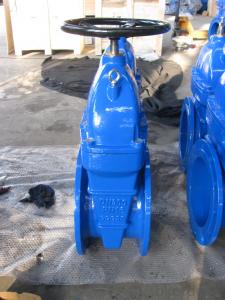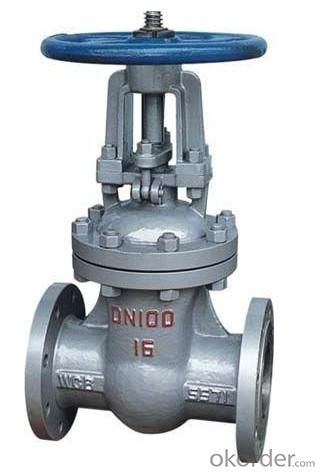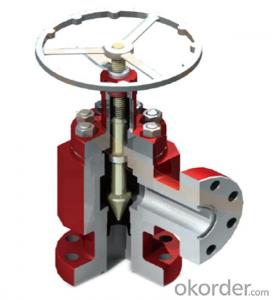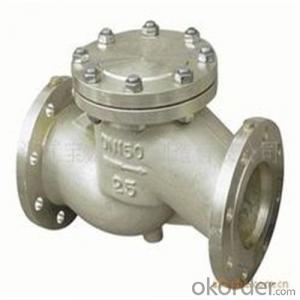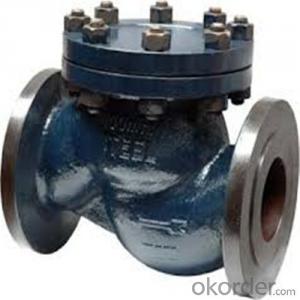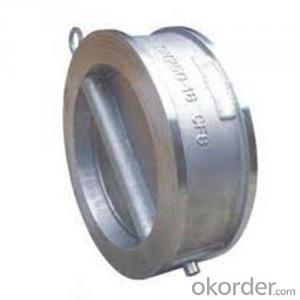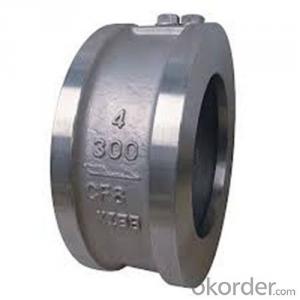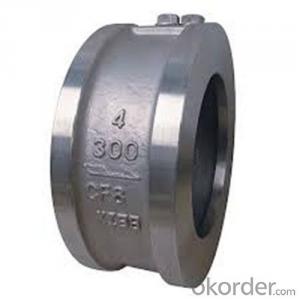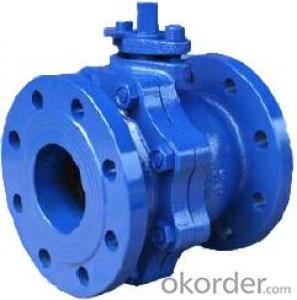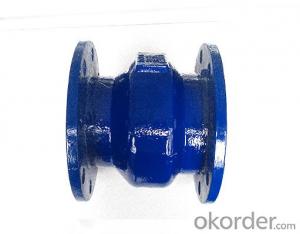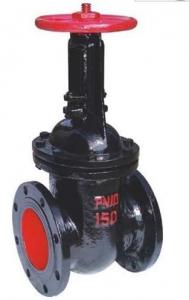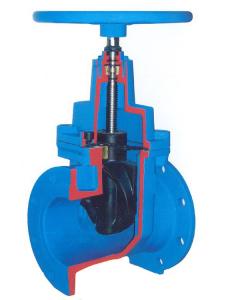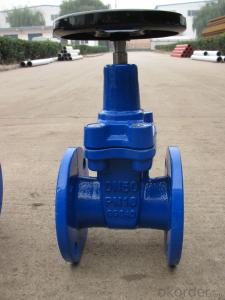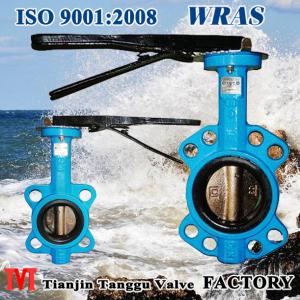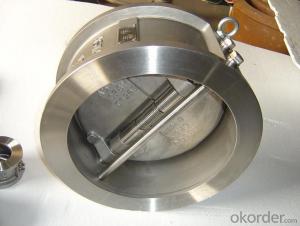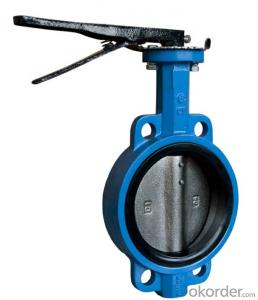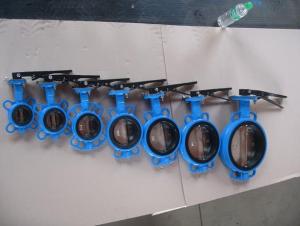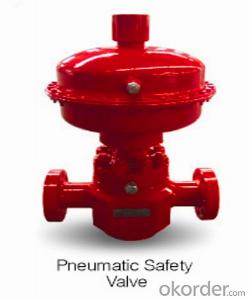DCI Gate Valve for Drinking Water System
- Loading Port:
- China main port
- Payment Terms:
- TT or LC
- Min Order Qty:
- 1000 set
- Supply Capability:
- 50000 set/month
OKorder Service Pledge
OKorder Financial Service
You Might Also Like
1. Structure of Gate Valve Description:
1. Selected materials, in line with domestic and international standards, high overall quality of the material.
2. In line with the requirements of domestic and foreign advanced standards, reliable sealing, excellent performance, attractive appearance.
3. Sealing pair advanced and reasonable, gate and seat sealing surface with different hardness Stellite (Stellite) cobalt-based alloy cladding made, reliable sealing, high hardness, wear resistance, high temperature, corrosion good anti-abrasion performance, long life.
4. Stem quenched and nitride surface treatment, has good corrosion resistance, scratch resistance and abrasion resistance.
5. The use of flexible wedge gate structure, medium and large caliber set thrust bearings, friction force is small, and with a striking manually open and close with ease.
2. Main Features of the Gate Valve:
1)Full port design
2)OS&Y Outside screw and yoke .
3)BB. Bolted Bonnet .
4)Flexible wedge, Fully guided
5)Choice of solid or split wedge .
6)Renewable seat rings
7)Forged T-head stem
8)Rising stem and non-rising handwheel
Working medium: water, non-corrosive liquid, saturated vapor (≤ 0.6MPa)
Operating temperature: -20 °C ≤ t ≤ 135 °C
Stem: non-rising stem
Body material:Brass/Stainless Steel
Connection:flanged
3. Images of the Gate Valve:

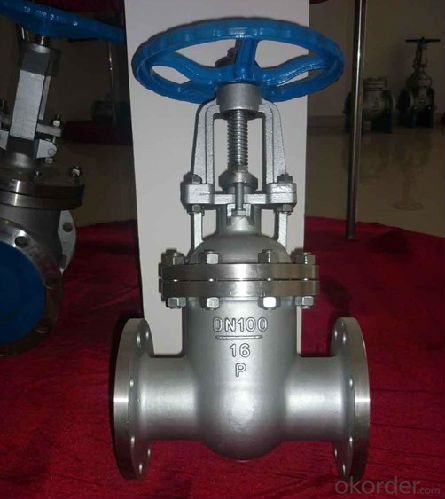
4. Specification of the Gate Valve:
1) Product information: the gate valves supplied are mainly used for adjusting water, steam, oil, gas, and natural gas in chemical industries
2) Standards: AWWA, DIN3352 F4/F5, BS5163, BS5150
3) Connection type: flanged type, push-on type, mechanical joint type, plain ends type
4) Material:
a) Body : Ductile Iron GGG500-7
b) Wedge : D/I , core fully vulcanized with NBR or EPDM rubber
c) Wedge Nut : Brass
d) Stem : Stainless steel , BS970 431S29 or DIN17440x20Cr13
e) Gasket : NBR
f) Bonnet : GGG500-7
g) O ring : NBR
h) Washer : Carbon steel or Stainless steel .
5.Connection Ends:
1)Socket Welded Dimension:ANSI B16.11,JB/T1751
2)Screw Ends Dimension:ANSI B1.20,JB/T7306
3)Butt Welded:ANSI B16.25
4)Flanged Ends:ANSI B16.5,JB79
5.FAQ
1. Can I get free samples?
A: Yes,we can provide you the free sample, but you need to bear their own delivery costs.
2. Can I request to change the form of packaging and transportation?
A:Yes, We can change the form of the packaging and transportation according to your request, but you have to bear their own costs incurred during this period and the spreads.
3. Can I request to advance the shipment?
A: It should be depends on whether there is sufficient inventory in our warehouse.
4. Can I have my own Logo on the product?
A: Yes, you can send us your drawing and we can make your logo, but you have to bear
their own the cost.
5. Can you produce the products according to my own drawings?
A:Yes,we can produce the products according to your drawings that will be most satisfy you.
- Q: My sprinkler valve I just put in leaks from the top knobs you turn to allow water to pass through to the 3 main pvc pipes. I turn the water on on the main water line, open the little black twisty knobs to allow the water to pass through to the irrigation lines, but water leaks out through all 3 black twisty knobs. What do I need to do?!?!?!
- I have been given the equivalent line from our water application while the strain valve broke and blew up our water softener it is the 1st concern on the line from their tension regulator. fortuitously, it has a lifetime insurance yet their plumber urged me that it incredibly was once the duty city on account that of the strain regulator which they admitted to being at fault as quickly as they replaced it.
- Q: I have mitral valve prolapse, I want to continue lifting weights.. Can i lift weights?here's my latest echo result.1. Normal left ventricular size with non-thickened walls with adequate wall motion and systolic function (EF = 70%)2. Normal left atrium without intracardiac thrombus3. Normal right atrium, right ventricle, main pulmonary artery and aortic root dimensions.4. The anterior mitral valve leaflet prolapses into the left atrium during ventricular systole.5. Structurally normal aortic valve, tricuspid valve and pulmonic valve.6. No pericardial effusion noted.COLOR FLOW DOPPLER STUDY:No abnormal color flow display across the valves, interatrial and interventricular septae.Normal pulmonary artery pressure by acceleration time.
- Good question, excellent details! The best advice I can give you, due to the complications associated with mitral valve prolapse, I would recommend you perform a stress test. Real easy procedure, heart rate is increased, generally by mechanical motion (ig running), cardiac cycle is monitored on screen. Basically here is the problem, your flaps on your mitral valve are being pushed back into the region of your heart that feeds the contracting area (left atrium), contracting region being the left ventricle. When this occurs, it greatly increases the possibility of back-flow of blood to the pulmonary veins and back to the lungs, which is REALLY bad. Without going into further detail, my best recommendation would be a stress test. Hope that helped. Good luck.
- Q: I noticed when I pulled my pcv valve off the valve cover the entire guts were missing. what would this make the car run like?
- Will run at higher idle and suck all the oil out of engine, then run bad until engine locks up and exhaust would be smoking like crazy. plus other things. Suggest you replace and check oil level.
- Q: i have a 1990 gmc sierra k1500, 4.3 v6. it has leaking valve seals its only smokes wen i first start it. so im not in to much of a hurry to replace them. wen i do replace them will i have to reset the timing and the valve gap? and could leaking valve seals cause loss of power or performance problems
- sounds like valve seals ! no you don,t have to bother the timing ! all you do is remove the plugs, hook up a air compressor and screw 1 end of the hose into the plug hole, take off the valve pan, loosen the rocker and start the compressor up ! once the compressor reaches about 40 to 50 pounds then take out the keeper on the valve stem and replace it with a new seal, if you can get the umbrella type seals, after the seal is replaced put the rocker back on, turn the crank by hand until the rocker is on the low cam and torque the rocker nut ! then you do the same way to the rest of the valve seals !
- Q: what are the symptoms of bad egr valve??? My car is shaking on idle.. Tune up with all has already been done.
- FIrst, locate remove and clean out your IDLE AIR CONTROL VALVE. This is the usual culprit. The EGR valve usually only need to be cleaned, as it gets clogged up with carbon. On may cars, I just disconnect them because they make the inside of the engine dirty. Using more modern spark plugs can lower emissions all by themselves. You can sometimes jolt the EGR back into shape by tapping on it with a hammer. Use Gum-out spray to clean your intake manifold out. It might just clean the EGR, too!
- Q: And' the valve leaks......Can the valve be unscrewed from the tank for replacement? Or can the valve be serviced with a new gasket perhaps?
- If it is a regular brass valve, you will have to drain the tank first, then replace the washer in the valve with one rated to be used for hot water. You replace the washer just as in any valve by removing the bonnet and stem. there you will see the washer. You may want to clean the area of any calcium carbonate that may had developed on the seat before putting it back together. If you decide to replace the valve, it is a 3/4 inch male NPT hose bib valve rated for hot water service. Personally, I've always thought that if I ever had to change one of those valves, that I would replace ti with a good ball valve that had a threaded hose end screwed into the discharge end for better drain flow. The whimpy valves that they put on water heaters is pathetic! If you use your favorite search engine and just search for water heater drain valve, you will find all kinds of cool replacement valves!
- Q: I saw that they sell a kit to block off the egr valve in my dodge neon. Since this was on a performance site what will this do? Will blocking off the valve give me more horsepower? Should I do it or not? Thanks
- If your vehicle has to pass an emission test in the state where you live, it will fail due to high NOX emissions. Aside from that, it's illegal in all 50 states. Generally speaking, blocking off the EGR will result in poorer fuel economy, possible engine detonation or pinging and higher combustion temperatures.
- Q: Would a 96 saturn egr valve work on a 96 camaro
- Why would it. They are from different cars, with different engines.
- Q: I was diagnosed with a VSD and a Biscuspid Aortic Valve and my doctor has started hinting towards sugery. I found out that the only reason i haven't had surgery yet is that it is stable enough to wait until technology improves so i am not left with a large scar. i was just wondering what this surgery would entail and if anyone has had it. I am 19 years old and kind of worried about it...
- VSD or ventricular septal defect is a congenital disease caused by failure of your ventricular septum to fuse with the bulbar ridges of your atrial septum during embryogenesis. Some VSD are fine since only a small amount of blood is shunted from LV to RV but a majority is still shunted straight to the aorta. An aortic valve stenosis which I think is what you are referring to is usually an adult disease associated with rheumatic fever, mechanical breakdown from hypertension, or death from an MI. Aortic valve stenosis is a bit more worrisome since this can lower the output of your heart by acting as an obstruction, which overtime can cause ventricular hypertrophy, a disease with whole set of other problems. New trends in VSD repair uses minimally-invasive surgery using a transcatheter that is inserted esophageally or through femoral artery; very small scars and short recovery time. Aortic valve repair may also be done this way in the future, but if your aortic valve is still patent, there is no need to replace it at this moment because it would require a donor and open heart surgery.
- Q: I don't know the principle of operation of the butterfly valve. Can I control the percentage of opening by an analog output from the PLC?
- Edit: the fast literal answer is no with the aid of be conscious in basic terms. each sort of valve may well be usually considered to be a pass administration device. maximum styles of valves, gate, globe, ball, B'fy may well be manually set everywhere from finished open to totally closed and can be set to any in part open place. The term administration valve usually refers to valves, which comprise butterfly types that are immediately regulated to modulate a cost of pass in accordance to a administration sign to the valve actuating device. in specific circumstances the sign is from a distant sensing element such with the aid of fact the temperature sensor controlling a refrigeration expansion valve. sometime the sign is from in the actuating device itself as in a water rigidity regulator on your place city water grant. The sign itself may well be modulating , as above or that's on/off which includes an emergency shutdown valve on a steam turbine or the on/off valve on your washer.
Send your message to us
DCI Gate Valve for Drinking Water System
- Loading Port:
- China main port
- Payment Terms:
- TT or LC
- Min Order Qty:
- 1000 set
- Supply Capability:
- 50000 set/month
OKorder Service Pledge
OKorder Financial Service
Similar products
Hot products
Hot Searches
Related keywords

